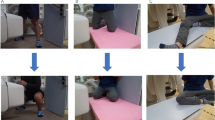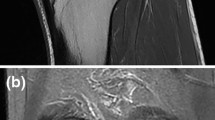Summary
The aim of this study is to suggest an anatomic study of the modifications of the length of the anterior cruciate ligament (ACL) and its bundles during flexion with the aid of a 3D computerized model of the knee in a living subject. The method of evaluation suggested is a 3D computerized reconstruction based on MRI sections, reproducing the movement of flexion of the knee from 0 to 75°. Twenty-one sections were made for each of the 13 positions of flexion. The reconstruction of Delaunay and the realignment of each position provided a 3D model which allowed monitoring of a bony point during the movement. By knowing the relative displacement of the ligamentous attachments it was possible to define the biometry of the ligament by calculating the length of the bundles of the ACL in each position and to demonstrate the variations in length during the movement. The mean length of the ligament was 3.4 mm. The anteromedial bundle was longer by 30% compared with the other two bundles. During flexion the anteromedial bundle was not much modified (this feature seems to provide a reference position for a ligamentoplasty), the posterolateral bundle became taut after 30°, and the intermediate bundle relaxed from the beginning of movement. Based on the data from the literature, this method allows an anatomic approach to the ACL, bundle by bundle, during flexion movement.
Résumé
Ce travail a pour but de proposer à l'aide d'un modèle informatique 3D du genou chez un sujet vivant une étude anatomique des modifications de longueur du ligament croisé antérieur (LCA) et de ses faisceaux au cours de la flexion. La méthode d'évaluation proposée est une reconstruction informatique 3D, à partir de coupes IRM, reproduisant le mouvement de flexion du genou de 0 à 75°. Vingt-et-une coupes ont été réalisées pour chacune des 13 positions de flexion. La reconstruction de Delaunay et le recalage de chaque position permettent d'obtenir un modèle 3D. Ce modèle permet le suivi d'un point osseux lors du mouvement. En connaissant le déplacement relatif des insertions ligamentaires, il est possible de préciser la biométrie du ligament en calculant la longueur des faisceaux du LCA à chaque position, de mettre en évidence les variations de longueur au cours du mouvement. La longueur moyenne du ligament était de 34 mm. Le faisceau antéro-médial était plus long de 30 % par rapport aux deux autres faisceaux. Lors de la flexion, le faisceau antéro-médial était peu modifié (cette caractéristique semblait en faire une position de référence pour une ligamentoplastie), le faisceau postéro-latéral se tendait à partir de 30°, le faisceau intermédiaire se détendait dès le début du mouvement. En retrouvant les données de la littérature, cette méthode permet une approche anatomique du LCA faisceau par faisceau lors du mouvement de flexion.
Similar content being viewed by others
References
Amis AA, Scammel BE (1991) Functional anatomy of the ACL. J Bone Joint Surg 75B: 812–817
Arnoczky SP (1983) Anatomy of the anterior cruciate ligament. Clin Orthop : 19–25
Berchuck M, Andriacchi T, Bach B, Reider B (1990) Gait adaptations by patients who have a deficient anterior cruciate ligament. J Bone Joint Surg (A) 72: 871–877
Blankevoort L, Huiskes R, De Lange A (1991) Recruitment of knee joint ligaments. J Biomech Eng 113: 95–103
Blankevoort L, Kuiper J, Huiskes R, Grootenboer H (1991) Articular contact in a three-dimensional model of the knee. J Biomech 24: 1019–1031
Boissonnat J (1988) Shape reconstruction from planar cross-sections. Computer vision, graphics and image processing 44: 1–29
Bousquet G, Le Béguec P, Girardin P (1991) Les laxités chroniques du genou. (1ère Edition.), Medsi/McGraw-Hill, Paris
Chambat P (1985) Le ligament croisé antérieur. In: Cahiers d'enseignement de la SOFCOT. Conférences d'enseignement 1985, ES Françaises, Paris, pp 79–101.
Clancy WG (1985) Intra articular reconstruction of the anterior cruciate ligament. Orthop Clin North Am 16: 181–189
Eckstein F, Sittek H, Milz S, Putz R, Reiser M (1994) The morphology of articular cartilage assessed by magnetic resonance imaging (MRI). Reproducibility and anatomical correlation. Surg Radiol Anat 16: 429–38
Fu F, Harner C, Johnson D, Miller M, Woo S (1993) Biomechanics of knee ligaments, basic concepts and clinical application. J Bone Joint Surg 75A: 1716–1727
Geiger B (1993) Construction et utilisation des modèle d'organes en yue de l'assistance au diagnostic et aux interventions chirurgicales. PhD Thesis, Ecole des Mines de Paris, Paris
Gely P, Droin G, Thiry P, Tremblay G (1984) Torsion and bending imposed on a new anterior cruciate ligament prosthesis during knee flexion: an evaluation method. J Biomech Eng 106: 285–294
Gerber C, Matter P (1983) Biomechanical analysis of the knee after rupture of the anterior cruciate ligament and its primary repair. J Bone Joint Surg 65B: 391–399
Hart R, Mote C, Skinner H (1991) A finite helical axis as a landmark for kinematic reference of the knee. J Biomech Eng 113: 215–222
Hefzy MS, Grood E, Noyes F (1989) Factors affecting the region of most isometric femoral attachments, part II: the anterior cruciate ligament. Am J Sports Med 17: 208–216
Huber H, Mattheck C (1988) The cruciate ligaments and their effect on the kinematics of the human knee. Med Biol Eng Comput 26: 647–653
Kapandji I (1980) Physiologie articulaire. Membre inférieur. Maloine, Paris
Kennedy J, Hawkin R, Willis R, Danylchuk R (1976) Tension studies of the human knee ligament. J Bone Joint Surg 58A: 350–355
Landjerit B, Bisserie M (1992) Cinématique spatiale de l'articulation fémoro-tibiale du genou humain: caractérisation expérimentale et implications chirurgicales. Acta Orthop Belg 2: 147–158
Markolf K, Gorek J, Kabo J, Shapiro M (1990) Direct measurement of resultant forces in the anterior cruciate ligament. J Bone Joint Surg 72A: 557–567
Migaud H, Gougeon F, Diop A, Lavaste F, Duquennoy A (1995) Analyse in vivo de la cinématique du genou: comparaison de quatre types de prothèses totales. Rev Chir Orthop 81: 198–208
Müller W (1994) The Knee. Springer-Verlag, New York
Norwood LA, Cross MJ (1979) Anterior cruciate ligament: functional anatomy of its bundles in rotatory instabilities. Am J Sports Med 7: 23–6
Noyes F, Butler D, Grood E, Zernicke R, Hefzy M (1984) Biomechanical analysis of human ligament grafts used in knee ligament repairs and reconstructions. J Bone Joint Surg 66A: 344–352
Noyes F, Keller C, Grood E, Butler D (1984) Advances in the understanding of knee ligament injury, repair, and rehabilitation. Med Sci Sports Exerc 16: 427–443
Odensten M, Gillquist J (1985) Functional anatomy of the ACL and a rationale for reconstruction. J Bone Joint Surg 67A: 257–262
Sapega A, Moyer R, Schneck C, Komalahiranya N (1990) Testing for isometry during reconstruction of the anterior cruciate ligament. J Bone Joint Surg 72A: 259–267
Author information
Authors and Affiliations
Rights and permissions
About this article
Cite this article
Boisgard, S., Levai, J.P., Geiger, B. et al. Study of the variations in length of the anterior cruciate ligament during flexion of the knee: use of a 3D model reconstructed from MRI sections. Surg Radiol Anat 21, 313–317 (1999). https://doi.org/10.1007/BF01631331
Received:
Accepted:
Issue Date:
DOI: https://doi.org/10.1007/BF01631331




